How to Store Potatoes for Winter UK: Long-Term Storage Methods
Master the art of storing potatoes through winter with our comprehensive UK guide. From proper curing techniques to ideal storage conditions, learn how to keep your homegrown potatoes fresh for 6+ months using proven methods that work in British climate conditions.
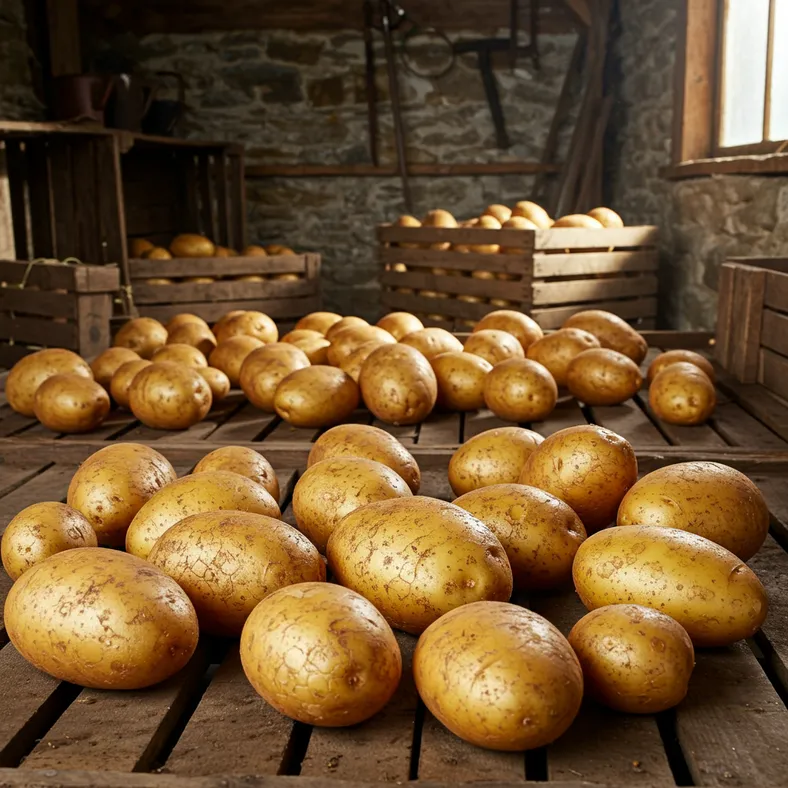
- Understanding Potato Storage Requirements
- Selecting the Right Potato Varieties for Storage
- Harvest Timing and Preparation
- The Curing Process: Essential First Step
- Storage Location Options for UK Homes
- Storage Container Selection and Setup
- Monitoring and Maintenance During Storage
- Troubleshooting Common Storage Issues
- Using Your Stored Potatoes Throughout Winter
Successfully storing potatoes for winter in the UK requires understanding specific temperature, humidity, and handling requirements that work with our climate conditions. Whether you've grown your own crop or purchased in bulk, proper storage techniques can keep potatoes fresh and flavourful for 6-8 months through winter.
The key to long-term potato storage lies in choosing the right varieties, curing them properly after harvest, and maintaining optimal environmental conditions. Maincrop varieties like King Edward, Maris Piper, and Desiree are specifically bred for winter storage, developing thick skins that protect against moisture loss and decay.
This comprehensive guide covers everything from initial harvest timing to setting up storage spaces that work in UK homes, helping you enjoy homegrown potatoes throughout the winter months while saving money on shop-bought alternatives.
Understanding Potato Storage Requirements
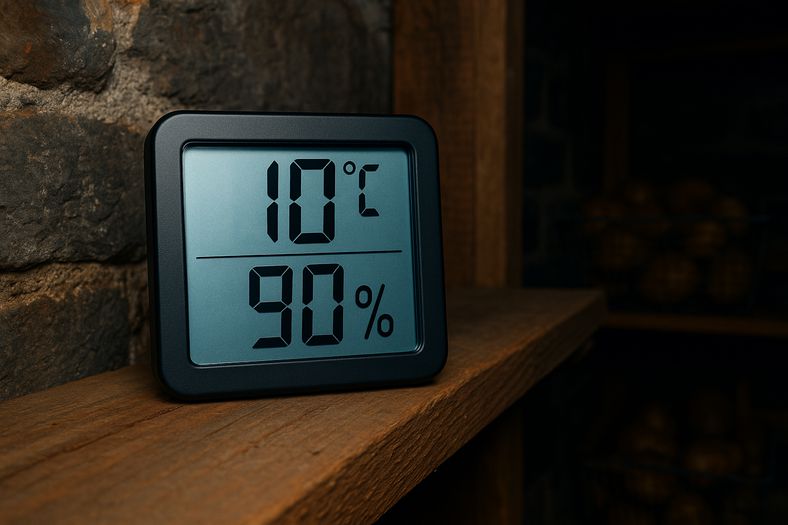
Proper potato storage requires maintaining specific environmental conditions that mimic underground cave-like environments. The ideal temperature range for long-term storage is 7-13°C (45-55°F), which prevents both sprouting and the conversion of starches to sugars that occurs below 4°C.
Humidity levels should remain between 85-95% to prevent dehydration whilst avoiding condensation that promotes rot. Air circulation is equally critical - potatoes continue respiring after harvest, requiring fresh air exchange to remove carbon dioxide and prevent anaerobic conditions.
Light exposure must be completely eliminated as it triggers glycoalkaloid production, causing potatoes to turn green and become toxic. Even brief exposure to fluorescent or LED lighting can initiate this process within days.
Key Storage Parameters:
- Temperature: 7-13°C (45-55°F)
- Humidity: 85-95% relative humidity
- Light: Complete darkness essential
- Air circulation: 15-25 air changes per hour minimum
- Duration: 6-8 months for properly cured maincrop varieties
Understanding these requirements helps explain why refrigerators, heated homes, and bright pantries all fail for long-term storage. The challenge for UK gardeners is creating these conditions using available spaces.
Selecting the Right Potato Varieties for Storage
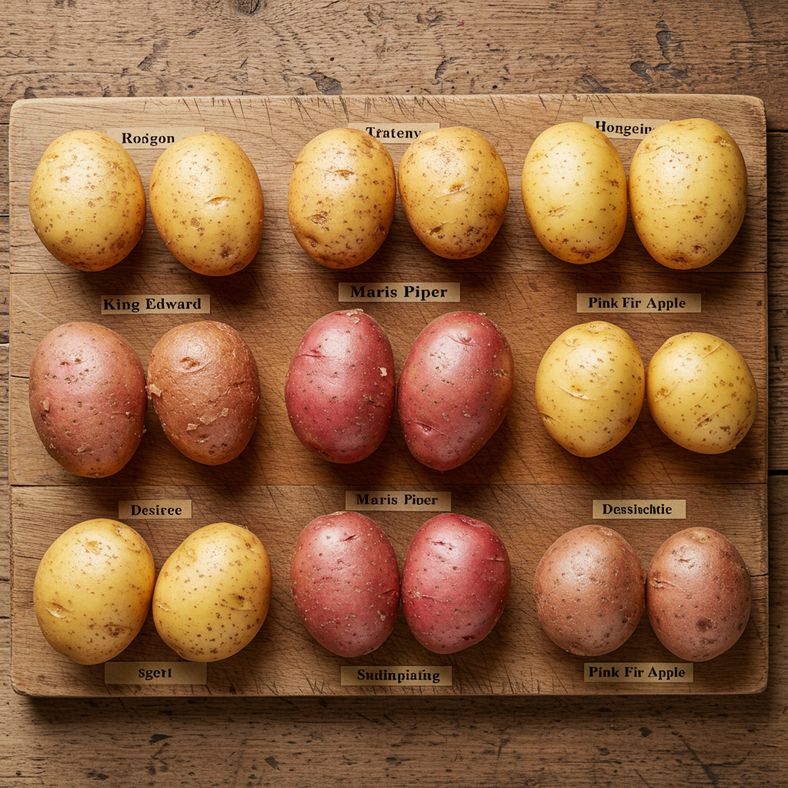
Not all potato varieties store equally well - maincrop varieties are specifically bred for long-term storage, whilst early varieties deteriorate rapidly and should be consumed within weeks of harvest.
Best UK Varieties for Winter Storage:
- King Edward: Classic British variety with excellent 6+ month storage life, perfect for roasting and baking
- Maris Piper: Reliable all-rounder with good disease resistance and storage capability
- Desiree: Red-skinned variety with exceptional drought tolerance and storage qualities
- Cara: Heavy cropping with sweet flavour, stores well for 4-6 months
- Sarpo Axona: Blight-resistant heritage variety that stores for 4+ months
- Pink Fir Apple: Unusual fingerling variety that stores exceptionally well for salad use
Maincrop varieties develop thick, protective skins and lower moisture content compared to earlies. They're typically harvested from late August through October, allowing full maturation essential for storage success.
Varieties to Avoid for Long-term Storage:
- First earlies (Jersey Royals, Rocket, Arran Pilot)
- Second earlies unless specifically noted for storage
- Any variety harvested as 'new potatoes'
- Damaged or diseased tubers regardless of variety
When growing for storage, allow plants to die back naturally rather than harvesting early. This ensures maximum skin development and starch concentration.
Harvest Timing and Preparation

Correct harvest timing is crucial for storage success. Never harvest potatoes whilst plants are still green - this produces 'new potatoes' with thin skins unsuitable for storage.
Proper Harvest Timing:
- Wait 2-3 weeks after foliage dies back completely
- Test skin firmness by rubbing - mature skins won't rub off easily
- Choose dry weather with no rain forecast for 3-5 days
- Harvest when soil temperature is below 13°C for easier handling
Harvest Technique:
- Use a garden fork rather than spade to minimise damage
- Dig carefully 30cm from plant centre, working inwards
- Lift entire root system to avoid missing tubers
- Handle gently - bruised potatoes won't store well
- Remove excess soil by brushing, never washing
Leave harvested potatoes on the soil surface for 2-3 hours to air-dry if conditions are dry and sunny. This initial drying helps remove surface moisture and begins the skin-hardening process.
Immediate Sorting:
- Remove any damaged, cut, or diseased potatoes for immediate use
- Separate different varieties for individual storage
- Grade by size - larger potatoes typically store longer
- Check for signs of pest damage (wireworm holes, slug damage)
Remember that one rotting potato can spoil an entire storage batch, so careful initial sorting prevents later losses.
The Curing Process: Essential First Step
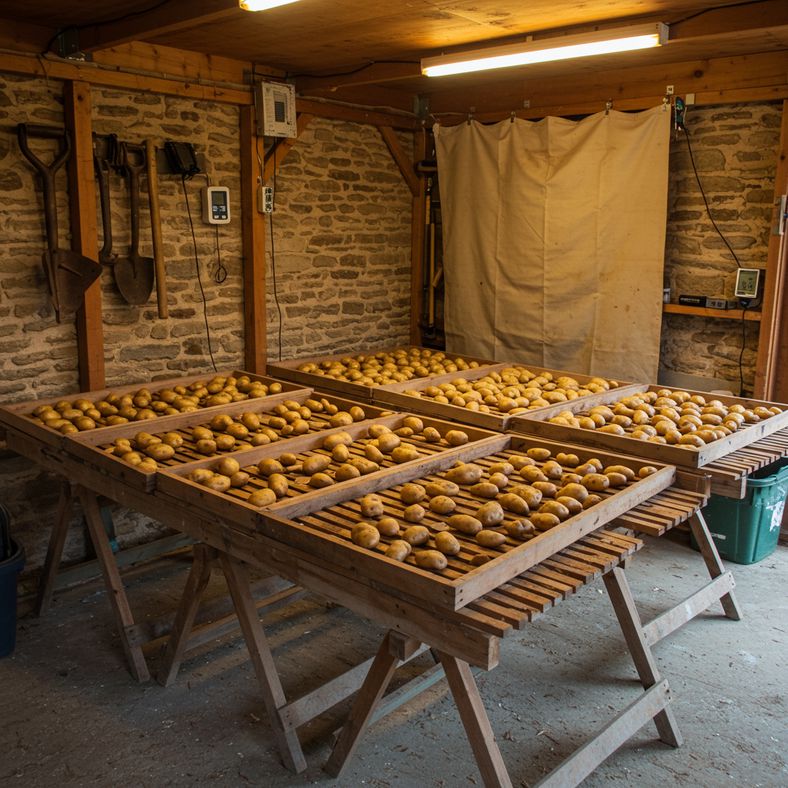
Curing is the most critical step for successful long-term storage, yet many gardeners skip this vital process. Proper curing extends storage life from 2-3 months to 6-8 months by allowing wounds to heal and skins to thicken.
Optimal Curing Conditions:
- Temperature: 10-15°C (50-60°F)
- Humidity: 85-95% relative humidity
- Duration: 10-14 days minimum
- Environment: Dark, well-ventilated space
- Air circulation: Gentle but consistent airflow
Setting Up a Curing Area:
- Use garage, shed, or basement with temperature control
- Spread potatoes in single layers on slatted wooden trays
- Ensure 5-10cm spacing between potatoes for air circulation
- Cover with breathable cloth to exclude light whilst allowing airflow
- Use small fan for air movement if space is poorly ventilated
What Happens During Curing:
- Harvest wounds heal through suberisation (cork formation)
- Skin cells multiply and thicken for better protection
- Surface moisture evaporates, reducing disease risk
- Starch content stabilises for better storage
Monitor temperature closely - below 10°C slows healing, whilst above 18°C increases disease risk. High humidity is essential during this phase, as dry conditions prevent proper wound healing.
Signs of Proper Curing:
- Skins feel firm and resistant to scratching
- Minor cuts and scrapes have formed protective layers
- Surface appears dry with no moisture beads
- Potatoes feel firm when gently squeezed
After curing, sort again to remove any potatoes showing signs of rot or failure to heal properly.
Storage Location Options for UK Homes

Most UK homes lack traditional root cellars, but several alternatives can provide suitable storage conditions with proper setup and monitoring.
Basement Storage:
Unheated basements often provide ideal conditions naturally. Key requirements:
- Consistent temperature between 7-13°C
- Good ventilation to prevent stagnant air
- Protection from heating systems and pipes
- Raised storage to prevent floor moisture contact
- Consider small dehumidifier if too damp
Garage Storage:
Attached or detached garages work well with modifications:
- Insulate against temperature extremes
- Use thermal mass (water containers) to moderate temperature swings
- Install min/max thermometer for monitoring
- Protect from car exhaust fumes
- Ensure rodent-proof containers
Shed Storage:
Garden sheds require insulation but offer good control:
- Add rigid foam insulation to walls and roof
- Install ventilation at floor and ceiling level
- Use thermal curtains for temperature buffering
- Position away from direct sunlight
- Consider small heater for extreme cold periods
Indoor Options:
For smaller quantities, indoor storage can work:
- North-facing cupboards or pantries
- Under-stair storage areas
- Spare bedroom corners (coolest areas)
- Wine fridges or beverage coolers set to 10°C
What to Avoid:
- Heated homes (temperature too high)
- Kitchen storage (temperature fluctuations)
- Refrigerator main compartments (too cold)
- Bright areas or near windows
- Areas prone to flooding or excessive moisture
The key is finding a space you can monitor and control, rather than hoping unsuitable conditions will work.
Storage Container Selection and Setup
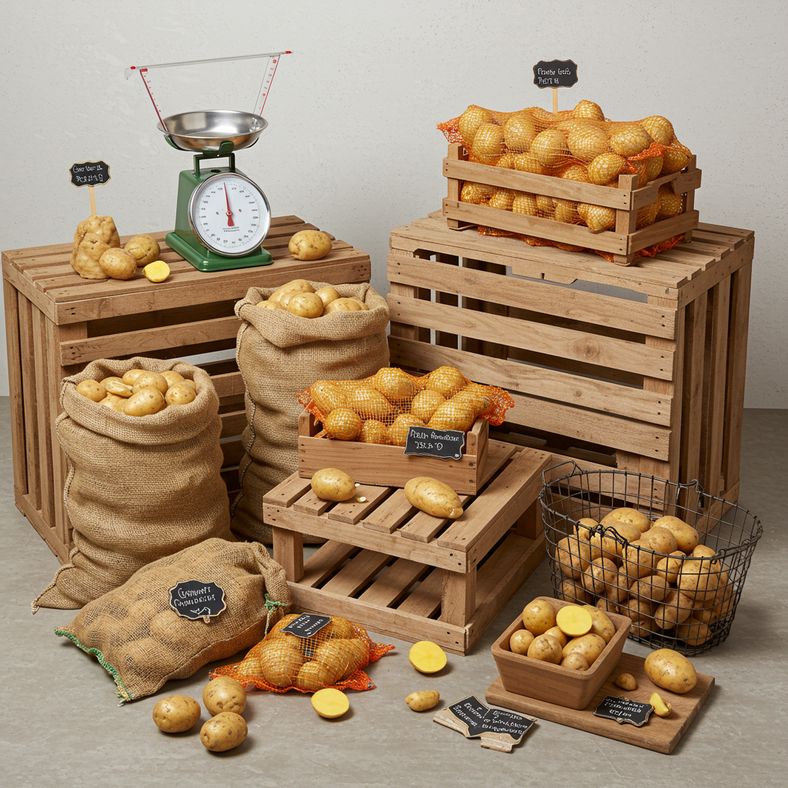
Choosing appropriate containers is crucial for maintaining proper airflow whilst protecting potatoes from light and pests. Different container types suit different storage volumes and conditions.
Hessian/Burlap Sacks:
Traditional choice offering excellent breathability:
- Hold 15-25kg depending on size
- Excellent air circulation prevents moisture buildup
- Natural fibres regulate humidity
- Stackable for efficient use of space
- Hang from rafters or stack on pallets
Perfect for basement or shed storage where containers won't be disturbed frequently.
Wooden Crates and Boxes:
Provide structure whilst allowing airflow:
- Use slatted sides for maximum ventilation
- Line with newspaper to catch soil
- Stack safely with proper support
- Easy to inspect contents without full emptying
- Natural material doesn't promote condensation
Perforated Plastic Containers:
Modern alternative with good durability:
- Lightweight and easy to handle
- Pest-resistant and easy to clean
- Transparent options allow visual inspection
- Stackable with consistent sizing
- Ensure adequate perforation for airflow
Paper Bags in Milk Crates:
Excellent for smaller quantities:
- Sort potatoes by size into separate bags
- 5-10kg per bag prevents overloading
- Easy to access individual varieties
- Remove spoiled potatoes without disturbing others
- Cover crates with cloth to exclude light
DIY Wire Basket System:
Create custom storage with hardware cloth:
- Build frames from 2x2 timber
- Attach 1cm mesh wire cloth for ventilation
- Create stackable modular units
- Easy inspection and access
- Customize size for available space
Container Setup Tips:
- Never store potatoes directly on concrete floors
- Use pallets or boards to allow air circulation underneath
- Leave 10-15cm between containers for airflow
- Cover with breathable materials like canvas or towels
- Label containers with variety and harvest date
For UK gardeners seeking quality storage solutions, consider investing in purpose-built potato storage sacks which offer professional-grade durability for multiple seasons of use.
Monitoring and Maintenance During Storage
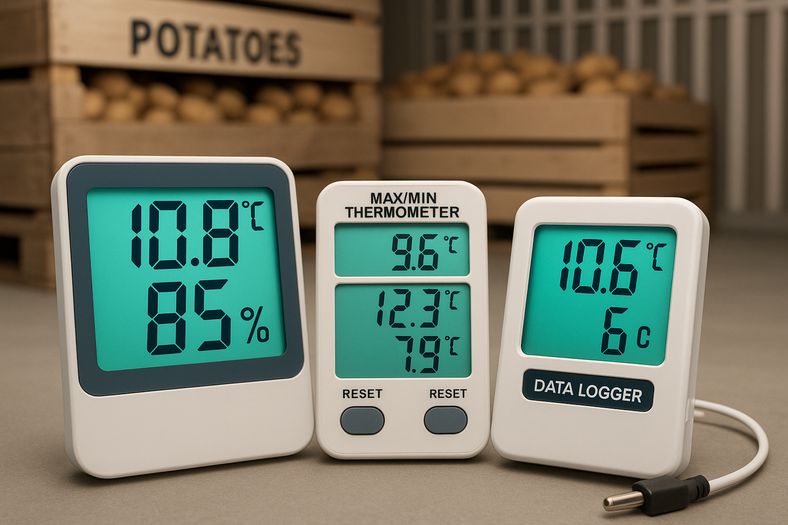
Regular monitoring prevents small problems becoming major losses. Establish a routine inspection schedule and maintain proper environmental conditions throughout the storage period.
Weekly Inspection Schedule:
- Check temperature and humidity readings
- Look for signs of sprouting, greening, or soft spots
- Remove any deteriorating potatoes immediately
- Ensure containers remain properly covered
- Check air circulation systems are functioning
Temperature Management:
- Install min/max thermometers in multiple locations
- Record daily temperatures for pattern recognition
- Adjust ventilation during warm spells
- Add insulation during extreme cold periods
- Use thermal mass (water containers) to moderate swings
Humidity Control:
- Monitor with digital hygrometers for accuracy
- Increase ventilation if condensation appears
- Add water containers if humidity drops below 80%
- Check for signs of dehydration (wrinkled skins)
- Balance air circulation with humidity retention
Common Storage Problems and Solutions:
- Sprouting: Temperature too high - increase ventilation, check for light leaks
- Greening: Light exposure - improve covering, check for gaps
- Soft rot: Poor ventilation or damaged potatoes - increase airflow, remove affected tubers
- Shrivelling: Low humidity - reduce ventilation, add humidity sources
- Sweet taste: Temperature too low - raise storage temperature gradually
Monthly Maintenance Tasks:
- Sort through containers to remove sprouted or soft potatoes
- Rotate stock, using oldest potatoes first
- Clean and reorganise storage areas
- Check rodent-proofing and pest control
- Test and calibrate monitoring equipment
Record Keeping:
Maintain simple logs to track:
- Daily temperature and humidity readings
- Potato variety and harvest dates
- Storage losses and reasons
- Weather conditions affecting storage
- Successful and unsuccessful techniques
This data helps optimise storage methods for following years and identifies patterns that affect storage success.
Troubleshooting Common Storage Issues
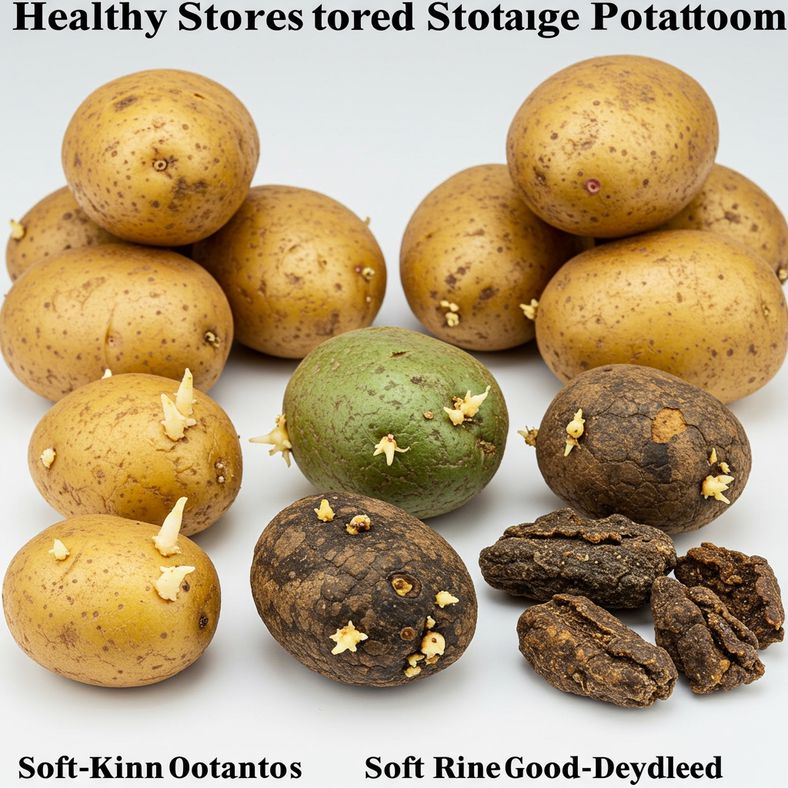
Even with proper setup, storage problems can occur. Quick identification and appropriate response prevent minor issues escalating into major losses.
Sprouting Problems:
Sprouting indicates temperature or light issues:
- Causes: Temperature above 13°C, light exposure, natural dormancy ending
- Solutions: Lower temperature, check light-proofing, improve ventilation
- Prevention: Maintain consistent cool temperatures, ensure complete darkness
- Action: Remove sprouts carefully, use sprouted potatoes quickly
Green Skin Development:
Greening makes potatoes toxic and inedible:
- Causes: Any light exposure, even brief fluorescent lighting
- Solutions: Improve covering, check for light leaks, relocate containers
- Prevention: Complete darkness essential, check covers regularly
- Action: Discard green potatoes - peeling doesn't remove toxins
Soft Rot and Decay:
Bacterial and fungal infections spread rapidly:
- Causes: Poor ventilation, high humidity, damaged potatoes, contamination
- Solutions: Increase airflow, remove affected potatoes immediately
- Prevention: Proper curing, careful handling, good ventilation
- Action: Isolate affected areas, improve storage conditions
Dehydration and Shrivelling:
Loss of moisture reduces quality:
- Causes: Low humidity, excessive ventilation, high temperatures
- Solutions: Reduce airflow, add humidity sources, check sealing
- Prevention: Monitor humidity levels, balance ventilation needs
- Action: Use shrivelled potatoes for cooking, not storage
Sweet Taste Development:
Cold-induced sweetening affects cooking quality:
- Causes: Storage temperature below 4°C converts starch to sugar
- Solutions: Gradually raise temperature to 10°C over 1-2 weeks
- Prevention: Maintain storage temperature above 7°C
- Action: Allow reconditioning period before use
Pest Issues:
Rodents and insects can devastate stored crops:
- Prevention: Sealed containers, regular cleaning, bait stations
- Signs: Droppings, gnaw marks, holes in potatoes
- Solutions: Improve container sealing, professional pest control
- Action: Remove contaminated potatoes, clean storage area thoroughly
Emergency Responses:
- Rapid temperature changes: Gradually adjust over several days
- Power failures: Use battery fans, open vents for natural circulation
- Flooding: Remove potatoes immediately, dry thoroughly before re-storage
- Equipment failure: Have backup monitoring and circulation systems
Using Your Stored Potatoes Throughout Winter
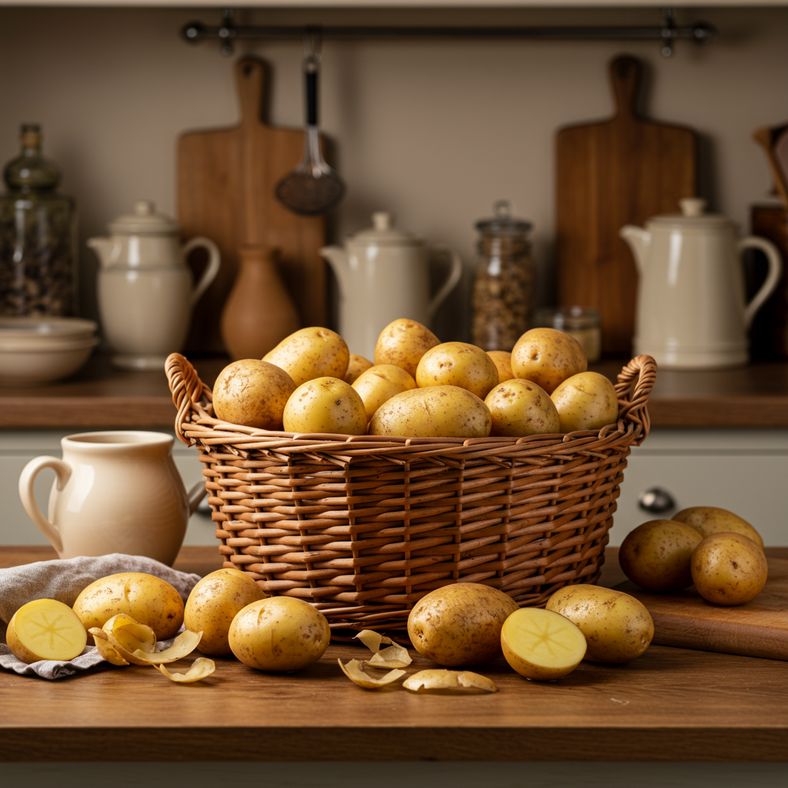
Proper rotation and usage ensures you enjoy the best quality potatoes whilst maximising storage life. Different storage periods affect cooking properties and nutritional content.
First 2-3 Months (October-December):
- Peak quality period with best texture and flavour
- Ideal for all cooking methods including roasting and baking
- Use any damaged or questionable potatoes first
- Monitor closely for early storage problems
Mid-Storage (January-March):
- Quality remains excellent with proper storage
- Some varieties may show minor sprouting - remove sprouts before use
- Perfect for mashing, chips, and general cooking
- Check storage conditions remain optimal
Late Storage (April-May):
- Natural dormancy ending - expect some sprouting
- Use quickly as sprouting accelerates
- Best for boiling, steaming, and processing
- Save best specimens for seed potatoes if desired
Quality Assessment Before Use:
- Check for firm texture - soft spots indicate deterioration
- Look for green patches - discard if present
- Remove sprouts and eyes before preparation
- Smell for off odours indicating spoilage
Cooking Considerations:
- Stored potatoes may require longer cooking times
- Sugar content increases slightly, affecting browning
- Texture becomes more floury over time
- Vitamin C content decreases gradually but remains significant
Maximising Usage:
- Rotate stock regularly, using oldest first
- Cook larger batches and freeze prepared dishes
- Share excess with neighbours and family
- Compost any unusable potatoes for next year's garden
Preparing for Cooking:
- Remove from storage 30 minutes before preparation
- Cut away any green areas completely
- Remove sprouts and deep eyes
- Wash thoroughly just before cooking
Well-stored potatoes provide excellent nutrition throughout winter, containing vitamin C, potassium, and fibre whilst offering versatility for countless meal preparations.